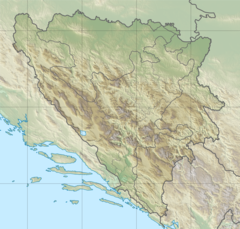| Pliva | |
|---|---|
 River Pliva near Jajce, in central Bosnia and Herzegovina, some 100 meters upstream from the waterfall. | |
 | |
| Location | |
| Country | Bosnia and Herzegovina |
| Region | Central Bosnia and Herzegovina |
| District | Central Bosnia Canton |
| Cities | Jajce, Šipovo, Jezero |
| Physical characteristics | |
| Source | Pljeva |
| • location | Smiljevac-Jastrebnjak mountain, Central Bosnia Canton, Central Bosnia and Herzegovina, Bosnia and Herzegovina |
| • elevation | 1,227 m (4,026 ft) |
| Mouth | Vrbas (river) |
• location | Jajce, Central Bosnia Canton, Central Bosnia and Herzegovina, Bosnia and Herzegovina |
• coordinates | 44°20′16″N 17°16′14″E / 44.3377°N 17.2706°E |
| Length | 26.8 km (16.7 mi)[1] |
| Basin size | 1,326 km2 (512 sq mi)[1] |
| Discharge | |
| • location | mouth, Jajce, Bosnia and Herzegovina |
| • average | 3 m3/s (110 cu ft/s) |
| Basin features | |
| Tributaries | |
| • right | Janj |
| Progression | Vrbas→ Sava→ Danube→ Black Sea |
The Pliva (Serbian Cyrillic: Плива) is a relatively small river in central parts of Bosnia and Herzegovina, however one of the most significant in terms of natural, cultural and historical heritage and value as a natural rarity. For hundreds of years this region was the ultimate stronghold of the Bosnian Kingdom, with the town of Jajce as permanent seat of the last kings of the Bosnian Kingdom.
The entire region of Jajce is rich in natural heritage that cannot be viewed in isolation from the built heritage. In Jajce, these two components are closely intermingled.[2]
- ^ a b "Sava River Basin Analysis Report" (PDF). International Sava River Basin Commission. September 2009. p. 13. Archived from the original (PDF, 9.98 MB) on 2010-07-17.
- ^ "Natural Heritage of the Pliva River and Region of Jajce". Commission to Preserve National Monuments of Bosnia and Herzegovina]. Archived from the original on 2007-12-25. Retrieved 2009-06-14.
Natural Heritage of the Pliva River and National Monuments of Bosnia and Herzegovina in the town of Jajce
